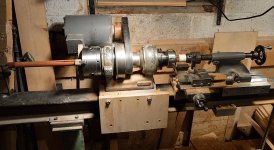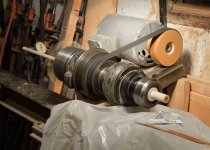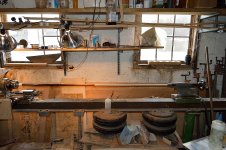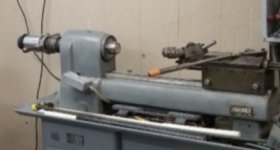Hi,
I am selling a very special lathe that has been modified for Cue Making. Here is a detailed history of the lathe, the modifications and maintence upgrades.
It is located in Las Vegas for inspection and pick up only. The Price is $ 6500.00 COD!
I bought this tool room secondary operations turret lathe from the Jeff Prather and his Dad 9 years ago.
I sent the headstock to NY and had the bearings redone for 2900 bucks plus shipping. It runs dead zero from the factory at any speed. It has never been used since for any work.
I had a machinist build a custom extension on the back of the spindle bore with a 600.00 unique big bore for the back chuck with delriln self adjusting internal paws.
For pin instalation you can place the butt in through the rear spindle and collet chuck it up on the joint, hold it in the back chuck and use the turret to center drill, drill, bore, tap and counter sink very fast and very accurately using the turret feature. The back chuck lands in the back 1/3 rd of the wrap area in this configuration.
Then you can also install the shaft into the chuck from the bed side and center drill, drill, bore and tap with a tapamatic. At dead zero. The Unique big bore back chuck will adjust to 1.375 or down to 11.7 mm shaft.
I did not buy the tapamatic, so not included.
I bought this unit when I had the mindset to do some production. But after retiring and moving to Vegas my plans changed and I decided to make only one or two cues per month at most and did not want to work too long each day.
At 69 and retired, I spend more time now playing jazz piano, working on and sailing my sailboat and persuing my life long passion for flying these days. Cue Making was never a job for me only an Art Interest.
So I have not really tried to sell the lathe. When I brought it back to Chicago from Oklahoma before doing the bearings and hot rod cue making up grades, Joey Gold offered me 5 grand on the spot as is!
Since I have no use for a production secondary lathe these days, I would consider selling it for 6500 dollars which is the exact amount I have invested in it. A smoking deal if someone wants to drive to Vegas. These lathes went for upward over 25k I am told.
If I do sell it, the buyer would have to back up a trailer in my garage here in Vegas where I have reinforced the roof trusses and have a chain fall rigged for lifting. I won't ship it! If you want to ship it, we can lower it onto and secure it onto a HD Pallet for a shipper you contract. No problem!
The lathe is buried in the back of my cue shop which is located behind my house.
To move that lathe to my garage would take me two days to move as i also have to move other machinery out, then to get a portable engine hoist back there and place it on my 6 caster lathe cart I built. So then I could move it to the garage out in front. Then re install my shop.
So I was planning to do this at some point this year. I knew a few years ago I was going to sell it, I have just been lazy.
Here are some pics. There is a video showing the lathe running at 1800 rpm and it is indicated on the outside of the chuck so there is a very slight wiggle within the zero line due to the chrome finish is not a ground dowel rod! If i had a dowel pin in a collet these lathes are accurate to 5 numbers with brand new bearings. The lathe is running and fully operational in my shop and i also have a 220v outlet in my garage if need be!
I also bought a brand new phase converter and had an electrictrician mount it in a wall box for 450 bucks total job in 2021. The micro switches in the controller box were changed also.
It can be set up to do many other operations also.
If you do production cue making, I don't think you a can do pins and machine shaft threading faster or more accurate than this set up with out going to a programed CNC lathe.
If you are a serious interested party, call me on the phone and I will be happy to discuss all the details at length.
Do not PM me or text me because I only wish to talk to serious interested potential buyers who understand what a smoking deal this is and understands what Hardinge lathes are all about. So please, no low ballers or tire kickers.
Rick Geschrey
Esoteric Cue
847 641 0276 between 6 am and 12 pm West Coast time.





I am selling a very special lathe that has been modified for Cue Making. Here is a detailed history of the lathe, the modifications and maintence upgrades.
It is located in Las Vegas for inspection and pick up only. The Price is $ 6500.00 COD!
I bought this tool room secondary operations turret lathe from the Jeff Prather and his Dad 9 years ago.
I sent the headstock to NY and had the bearings redone for 2900 bucks plus shipping. It runs dead zero from the factory at any speed. It has never been used since for any work.
I had a machinist build a custom extension on the back of the spindle bore with a 600.00 unique big bore for the back chuck with delriln self adjusting internal paws.
For pin instalation you can place the butt in through the rear spindle and collet chuck it up on the joint, hold it in the back chuck and use the turret to center drill, drill, bore, tap and counter sink very fast and very accurately using the turret feature. The back chuck lands in the back 1/3 rd of the wrap area in this configuration.
Then you can also install the shaft into the chuck from the bed side and center drill, drill, bore and tap with a tapamatic. At dead zero. The Unique big bore back chuck will adjust to 1.375 or down to 11.7 mm shaft.
I did not buy the tapamatic, so not included.
I bought this unit when I had the mindset to do some production. But after retiring and moving to Vegas my plans changed and I decided to make only one or two cues per month at most and did not want to work too long each day.
At 69 and retired, I spend more time now playing jazz piano, working on and sailing my sailboat and persuing my life long passion for flying these days. Cue Making was never a job for me only an Art Interest.
So I have not really tried to sell the lathe. When I brought it back to Chicago from Oklahoma before doing the bearings and hot rod cue making up grades, Joey Gold offered me 5 grand on the spot as is!
Since I have no use for a production secondary lathe these days, I would consider selling it for 6500 dollars which is the exact amount I have invested in it. A smoking deal if someone wants to drive to Vegas. These lathes went for upward over 25k I am told.
If I do sell it, the buyer would have to back up a trailer in my garage here in Vegas where I have reinforced the roof trusses and have a chain fall rigged for lifting. I won't ship it! If you want to ship it, we can lower it onto and secure it onto a HD Pallet for a shipper you contract. No problem!
The lathe is buried in the back of my cue shop which is located behind my house.
To move that lathe to my garage would take me two days to move as i also have to move other machinery out, then to get a portable engine hoist back there and place it on my 6 caster lathe cart I built. So then I could move it to the garage out in front. Then re install my shop.
So I was planning to do this at some point this year. I knew a few years ago I was going to sell it, I have just been lazy.
Here are some pics. There is a video showing the lathe running at 1800 rpm and it is indicated on the outside of the chuck so there is a very slight wiggle within the zero line due to the chrome finish is not a ground dowel rod! If i had a dowel pin in a collet these lathes are accurate to 5 numbers with brand new bearings. The lathe is running and fully operational in my shop and i also have a 220v outlet in my garage if need be!
I also bought a brand new phase converter and had an electrictrician mount it in a wall box for 450 bucks total job in 2021. The micro switches in the controller box were changed also.
It can be set up to do many other operations also.
If you do production cue making, I don't think you a can do pins and machine shaft threading faster or more accurate than this set up with out going to a programed CNC lathe.
If you are a serious interested party, call me on the phone and I will be happy to discuss all the details at length.
Do not PM me or text me because I only wish to talk to serious interested potential buyers who understand what a smoking deal this is and understands what Hardinge lathes are all about. So please, no low ballers or tire kickers.
Rick Geschrey
Esoteric Cue
847 641 0276 between 6 am and 12 pm West Coast time.

richard shared 1 photo with you
www.amazon.com

richard shared 1 photo with you
www.amazon.com

richard shared 1 photo with you
www.amazon.com

richard shared 1 video with you
www.amazon.com

richard shared 1 photo with you
www.amazon.com
Last edited:




